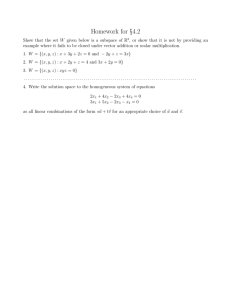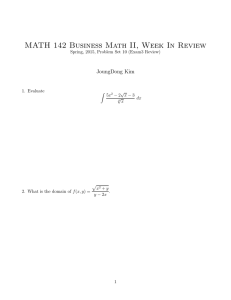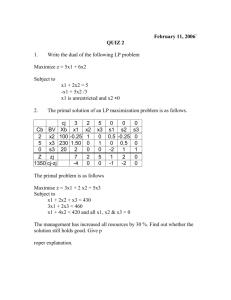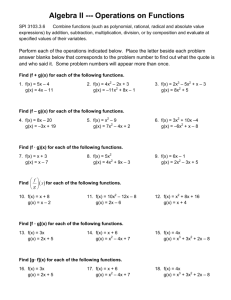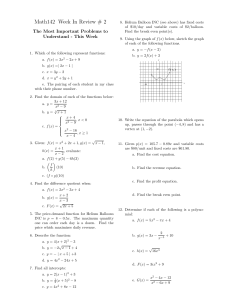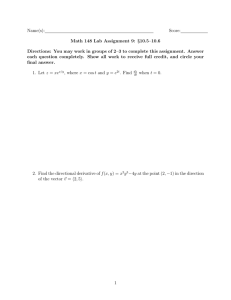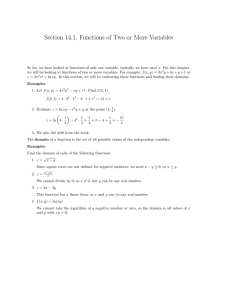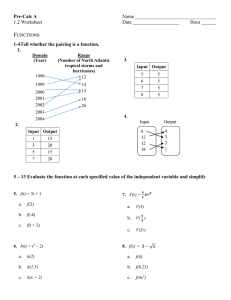IP Formulation guide (abbreviated) 15.053 and 15.058 Spring 2013
advertisement
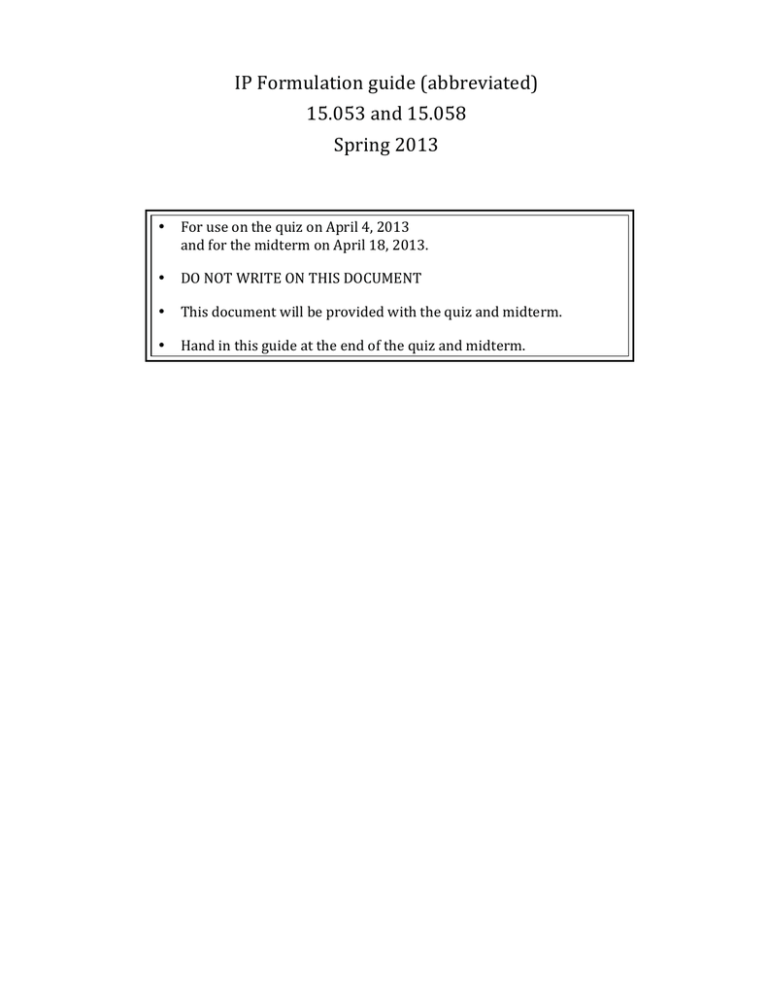
�
IP Formulation guide (abbreviated)
15.053 and 15.058
Spring 2013
• For use on the quiz on April 4, 2013
and for the midterm on April 18, 2013.
• DO NOT WRITE ON THIS DOCUMENT
• This document will be provided with the quiz and midterm.
• Hand in this guide at the end of the quiz and midterm.
1M����Packinv,�coverinv,�anp�rartitioninv�rroblemsM�
There is a collection of sets S1, ., Sn with Si C {1, 2, 3, ., m} for i = 1 to n.
Associated with each set Si is a cost ci.
⎧⎪ 1
if i ∈S j
⎪⎩ 0
otherwise.
Let aij = ⎨
⎧⎪ 1
if set S j is selected
⎪⎩ 0
otherwise.
Let x j = ⎨
The set packing problem is the problem of selecting the maximum cost subcollection of sets, no two of which
share a common element. The set covering problem is the problem of selecting the minimum cost
subcollection of sets, so that each element i E {1, 2, ., m} is in one of the sets.
Maximize
∑
∑
n
j=1
n
subject to
cjxj
a x j
≤ 1 for each i ∈{1,...,m}
j=1 ij
x j ∈{0,1}
∑
∑
Minimize
subject to
n
j=1
n
Set Packing Problem
for each j ∈{1,...,n}.
cjxj
a x j ≥ 1 for each i ∈{1,...,m}
j=1 ij
x j ∈{0,1}
Set Covering Problem
for each j ∈{1,...,n}.
Section�.M����opular�aritmmeticM
�
x = a (mod b) is the same as: there is an integer q such that a + qb = x. integer.�
�
ConstraintM�
IP�Constraint�
x is odd.
x - 2W = 1, W � 0, W is integral.
x is even.
x - 2W = 0, W � 0, W is integral.
x = a (mod b)
x - bW = a, W � 0, W is integral.
Table�1M��Modular arithmetic formulations.
�
3M��sestrictinv�a�variable�to�take�on�one�ov�several�valuesM�
x E {4, 8, 13}
x = 4 W1 + 8 W2 + 13 W3;
W1 + W2 + W3 = 1
Wi E {0, 1} for i = 1 to 3.
x E {0, 4, 8, 13}
x = 4 W1 + 8 W2 + 13 W3;
W1 + W2 + W3 � 1
Wi E {0, 1} for i = 1 to 3.
�
2
Lovical�ConstraintsM�
IP�Constraint�
If item i is selected, then item j is also selected.
xi - xj � 0
Either item i is selected or item j is selected, but not both.
xi + xj = 1
Item i is selected or item j is selected or both.
xi + xj � 1
If item i is selected, then item j is not selected.
xi + xj � 1
If item i is not selected, then item j is not selected.
-xi +xj � 0
At most one of items i, j, and k are selected.
xi + xj + xk � 1
Exactly one of items i, j, and k are selected.
xi + xj + xk = 1
At least one of items i, j and k are selected.
xi + xj + xk � 1
Table�.M���Simple constraints involving two or three binary variables.
4M���Lovical�constraints�anp�tme�biv���metmopM�
In the following, we assume that all integer variables are bounded from above. We also assume that all
variables are required to be integer valued. We let M denote some very large integer.
Logical Constraints using big M method. x1 + 4x2 -­‐ 2x4 ≥ 7 or 3x1 -­‐ 5x2 ≤ 12 If x1 + 4x2 -­‐ 2x4 ≥ 7 then 3x1 -­‐ 5x2 ≤ 12 At least two of the following constraints are satisfied: x1 + 4x2 + 2x4 ≥ 7; 3x1 -­‐ 5x2 ≤ 12; 2x2 + x3 ≥ 6; At most one of the following constraints are satisfied: x1 + 4x2 + 2x4 ≥ 7; 3x1 -­‐ 5x2 ≤ 12; 2x2 + x3 ≥ 6 ; IP Constraint x1 + 4x2 -­‐ 2x4 ≥ 7 -­‐ M w 3x1 -­‐ 5x2 ≤ 12 + M(1-­‐w) w ∈ {0,1} x1 + 4x2 -­‐ 2x4 ≤ 6 + M w 3x1 -­‐ 5x2 ≤ 12 + M(1-­‐w) w ∈ {0,1} x1 + 4x2 + 2x4 ≥ 7 -­‐ M(1-­‐w1) 3x1 -­‐ 5x2 ≤ 12 + M(1-­‐w2) 2x2 + x3 ≥ 6 -­‐ M(1-­‐w3) w1 +w2 +w3 ≥ 2 wi ∈ {0,1} for i = 1 to 3. This is equivalent to : at least two of the following constraints are satisfied. x1 + 4x2 + 2x4 ≤ 6; 3x1 -­‐ 5x2 ≥ 13; 2x2 + x3 ≤ 5; 3
3 5M��Fidep�costs�
Here we consider an integer program in which there are fixed costs on variables. For example, consider the
following integer program:
Formulation�usinv�videp�costs�
f (x1 ) + f 2 (x2 ) + f3 (x3 )
Maximize
2x1 + 4x2 + 5x3 ≤ 100
subject to
IP�Formulation�
Maximize
subject to
52x1 − 500w1 + 30x2 − 400w2 + 20x3 − 300w3
2x1 + 4x2 + 5x3 ≤ 100
x1 + x2 + x3 ≤ 30
x1 + x2 + x3 ≤ 30
10x1 + 5x2 + 2x3 ≤ 204
10x1 + 5x2 + 2x3 ≤ 204
xi ≤ Mwi
xi ≥ 0 and integer for i = 1 to 3.
for i = 1 to 3
xi ≥ 0 and integer for i = 1 to 3.
⎧ 20x − 300
⎧ 30x − 400 if x ≥ 1
⎧
⎪
3
2
2
where f (x ) = ⎪⎨ 52x1 − 500 if x1 ≥ 1 , f (x ) = ⎪⎨
, and f3 (x3 ) = ⎨
2
2
1 1
0
0
if
x
=
0
0
if
x
=
0
⎪⎩
⎪⎩
2
⎪⎩
1
if x3 ≥ 1
if x3 = 0
.
Section�6M��Piece�ise�linear�vunctionsM
Integer programming can be used to model functions that are piecewise linear. For example, consider the
following function.
⎧ 2x
⎪
y = ⎨ 9− x
⎪
⎩ −5 + x
if 0 ≤ x ≤ 3
if 4 ≤ x ≤ 7
if 8 ≤ x ≤ 9.
One can model y in several different ways. Here is one of them. We first define two new variables for every
piece of the curve.
Devinitions�ov�tme�variables�
IP�vormulation�
⎧⎪ 1
w1 = ⎨
⎪⎩ 0
if 0 ≤ x ≤ 3
otherwise.
⎧⎪ x
x1 = ⎨
⎩⎪ 0
⎧⎪ 1
w2 = ⎨
⎩⎪ 0
if 4 ≤ x ≤ 7
otherwise.
⎧⎪ x
x2 = ⎨
⎩⎪ 0
if 4 ≤ x ≤ 7
⎧⎪ 1
w3 = ⎨
⎪⎩ 0
if 8 ≤ x ≤ 9
otherwise.
⎧⎪ x
x3 = ⎨
⎪⎩ 0
if 8 ≤ x ≤ 9
if 0 ≤ x ≤ 3
otherwise.
otherwise.
otherwise.
0 ≤ x1 ≤ 3w1 4w2 ≤ x2 ≤ 7w2 8w3 ≤ x3 ≤ 9w3 w1 + w2 + w3 = 1 x = x1 + x2 + x3 wi ∈ {0, 1} for i = 1 to 3. 4 MIT OpenCourseWare
http://ocw.mit.edu
15.053 Optimization Methods in Management Science
Spring 2013
For information about citing these materials or our Terms of Use, visit: http://ocw.mit.edu/terms.
